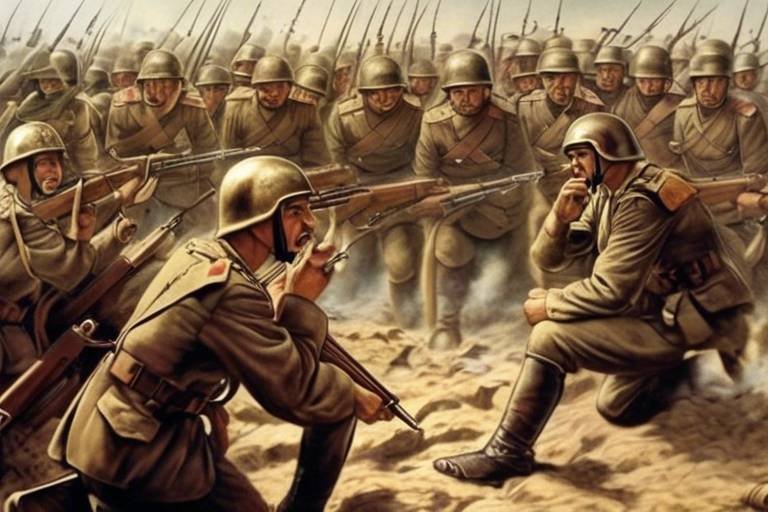The Rise of Totalitarianism in the 20th Century
Throughout the tumultuous 20th century, the world witnessed the ominous rise of totalitarianism, a political ideology that gripped nations in its iron fist, leaving a trail of devastation and despair in its wake. Totalitarian regimes emerged like a sudden storm, engulfing societies in a whirlwind of control and oppression. The impact of these regimes reverberated far and wide, reshaping the course of history and leaving an indelible mark on the collective consciousness of humanity.

Origins of Totalitarianism
The origins of totalitarianism can be traced back to the tumultuous period of the early 20th century, characterized by widespread economic instability, social unrest, and political turmoil. In the aftermath of World War I, many European nations were grappling with the devastating consequences of the conflict, leading to a sense of disillusionment and despair among the population. The failure of traditional political systems to address the pressing issues of the time created fertile ground for the emergence of radical ideologies that promised swift and decisive solutions to the prevailing crises.
The devastating impact of the Great Depression further exacerbated the already fragile state of many countries, fueling discontent and paving the way for the rise of authoritarian leaders who capitalized on popular discontent to seize power. The erosion of democratic norms and institutions, coupled with the erosion of civil liberties, created an environment conducive to the establishment of totalitarian regimes that sought to exert total control over every aspect of society.
Totalitarianism found fertile ground in the aftermath of World War I, as disillusionment with the existing political order and the desire for radical change fueled the rise of charismatic leaders who promised to restore order and greatness to their nations. The allure of these leaders lay in their ability to tap into the fears and aspirations of the masses, offering a vision of a utopian society free from the perceived decadence and corruption of the past.

Key Characteristics of Totalitarianism
Exploring the emergence and impact of totalitarian regimes in the 20th century, including key characteristics, leaders, ideologies, and the lasting effects on society and politics.
Examining the historical context and factors that led to the rise of totalitarian regimes in the early 20th century, such as economic instability, social upheaval, and political disillusionment.
Totalitarianism is characterized by a set of distinct features that define its oppressive nature and control over society. One of the key characteristics is centralized control, where the government holds absolute power and authority over all aspects of life. This control extends to the suppression of dissent, where any opposition or criticism is swiftly silenced through censorship, imprisonment, or violence.
Another hallmark of totalitarianism is the pervasive use of propaganda to manipulate public opinion and shape the narrative in favor of the ruling regime. This propaganda often revolves around creating a cult of personality around the leader, portraying them as an infallible and revered figure. Additionally, totalitarian states rely on terror as a tool to instill fear and maintain power, using tactics such as secret police, surveillance, and arbitrary arrests.
Exploring the figures who epitomized totalitarian rule, such as Adolf Hitler, Joseph Stalin, Benito Mussolini, and their methods of consolidating power and enforcing ideological conformity.
Analyzing the ideological foundations of totalitarian regimes, such as fascism, Nazism, communism, and their impact on state policies, social structures, and individual freedoms.
Investigating the mechanisms of control and surveillance employed by totalitarian states to monitor and regulate the behavior of citizens, including secret police, censorship, and propaganda.
Examining the various forms of resistance and dissent against totalitarian regimes, from underground movements and rebellions to intellectual criticism and international condemnation.
Reflecting on the enduring legacy of totalitarianism in the 20th century, including its influence on modern politics, human rights, and the collective memory of past atrocities.
Drawing lessons from the rise of totalitarianism for contemporary societies, discussing the importance of safeguarding democracy, upholding individual liberties, and preventing the resurgence of authoritarianism.
Stay tuned for answers to commonly asked questions about totalitarianism and its impact on society and politics.

Totalitarian Leaders
When delving into the dark history of the 20th century, one cannot ignore the towering figures who embodied the essence of totalitarian rule. Adolf Hitler, the charismatic leader of Nazi Germany, Joseph Stalin, the ruthless dictator of the Soviet Union, and Benito Mussolini, the fascist ruler of Italy, stand out as the epitome of totalitarian leaders who left an indelible mark on history.
These leaders employed various tactics to consolidate power and enforce ideological conformity within their respective regimes. Hitler's use of propaganda through the infamous Ministry of Public Enlightenment and Propaganda, Stalin's brutal purges of political opponents through the secret police, and Mussolini's cult of personality all served to maintain their iron grip on power and instill fear in the hearts of their subjects.
One of the key characteristics shared by these totalitarian leaders was their ability to manipulate the masses through rhetoric and coercion. Hitler's fiery speeches mesmerized crowds, Stalin's iron-fisted rule instilled terror, and Mussolini's grandiose vision of a revived Roman Empire captivated the imagination of the Italian people.
Moreover, these leaders implemented policies that aimed to control every aspect of society, from the economy to culture, from education to the military. They sought to create a homogeneous society that adhered strictly to their ideological principles, crushing any form of dissent or opposition along the way.
Despite their differences in ideology and methods, Hitler, Stalin, and Mussolini shared a common goal of total domination and control. Their legacies are stained with bloodshed, oppression, and atrocities that continue to haunt the collective memory of humanity, serving as a stark reminder of the dangers of unchecked power and totalitarianism.

Ideologies of Totalitarianism
When delving into the ideologies of totalitarianism, one cannot ignore the profound impact these belief systems had on shaping the course of history in the 20th century. Totalitarian regimes were built upon rigid ideologies that sought to control every aspect of society, from political structures to individual thoughts and behaviors. These ideologies, such as fascism, Nazism, and communism, served as the guiding principles that justified the authoritarian rule and oppressive practices of totalitarian states.
One of the most infamous ideologies associated with totalitarianism is fascism, characterized by extreme nationalism, militarism, and the glorification of the state. Leaders like Benito Mussolini in Italy and Adolf Hitler in Germany propagated fascist ideologies that emphasized the supremacy of the nation and the need for strict social hierarchy. The cult of personality surrounding these dictators further reinforced the fascist ideology, portraying them as infallible leaders whose word was law.
Nazism, a form of fascism specific to Germany under Hitler's rule, introduced the abhorrent ideology of racial superiority and anti-Semitism. The Nazis' belief in the Aryan race's dominance and their systematic persecution of Jews, Romani people, and other marginalized groups exemplified the extreme consequences of totalitarian ideologies taken to their logical extreme.
On the other end of the spectrum, communism, as espoused by figures like Joseph Stalin in the Soviet Union, aimed to create a classless society through the abolition of private property and the establishment of a centralized, state-controlled economy. While communism purported to champion the rights of the working class, in practice, it often led to widespread repression, surveillance, and the suppression of dissenting voices in the name of achieving a utopian society.
These ideologies of totalitarianism not only dictated state policies but also permeated every aspect of society, influencing cultural norms, educational curricula, and even personal relationships. The rigid adherence to these belief systems stifled individual freedoms, creativity, and critical thinking, creating a monolithic society where deviation from the official ideology was met with harsh punishment.

Totalitarian Control and Surveillance
In the realm of totalitarian regimes, control and surveillance are not just tools but pillars that uphold the entire structure of power. Totalitarian governments go to great lengths to monitor and regulate the lives of their citizens, instilling fear and obedience through pervasive surveillance mechanisms. Imagine a society where every move you make, every word you speak, and every thought you have are scrutinized by an all-seeing eye, where even the slightest hint of dissent is swiftly quashed by the iron fist of the state.
Central to the concept of totalitarian control is the presence of secret police forces, such as the Gestapo in Nazi Germany or the KGB in Stalinist Russia. These organizations operate in the shadows, infiltrating every aspect of society to root out potential threats to the regime. Citizens live in constant fear of being reported on by their neighbors, friends, or even family members, creating a culture of mistrust and paranoia that permeates every interaction.
Censorship is another powerful tool used by totalitarian states to control the flow of information and suppress dissenting voices. Books, newspapers, and radio broadcasts are carefully monitored and censored to ensure that only approved narratives are disseminated to the public. Any hint of criticism or alternative viewpoints is swiftly silenced, leaving citizens with a narrow and distorted view of the world around them.
Propaganda plays a crucial role in shaping the minds of the populace, painting the regime in a favorable light while demonizing any opposition. Totalitarian leaders cultivate a cult of personality around themselves, presenting an image of strength and infallibility to their followers. Through relentless propaganda campaigns, they manipulate public opinion and create a sense of unity and purpose among the masses, even as they tighten their grip on power.
Surveillance extends beyond the physical realm into the realm of thought and belief. Totalitarian regimes seek to control not only the actions of their citizens but also their minds, imposing strict ideological conformity through indoctrination and propaganda. Dissent is not just punished but eradicated, as any deviation from the official state ideology is seen as a threat to the stability of the regime.
In the face of such pervasive control and surveillance, resistance may seem futile, but throughout history, brave individuals and groups have stood up against the oppressive machinery of totalitarianism. From underground movements and acts of civil disobedience to intellectual dissent and international condemnation, the human spirit has shown its resilience in the face of tyranny. The struggle for freedom and autonomy continues, reminding us that even in the darkest of times, the light of resistance can never be extinguished.

Resistance to Totalitarianism
Resistance to totalitarian regimes took various forms throughout history, reflecting the indomitable human spirit in the face of oppression and tyranny. From daring underground movements to courageous acts of defiance, individuals and groups stood up against the pervasive control and suppression imposed by totalitarian leaders. One notable form of resistance was through intellectual criticism, where writers, artists, and thinkers used their creativity and intellect to challenge the propaganda and censorship of the regime.
Furthermore, underground networks played a crucial role in organizing acts of resistance, from distributing forbidden literature to orchestrating protests and strikes in defiance of the oppressive regime. These clandestine efforts often operated in the shadows, evading the watchful eyes of the secret police and risking severe reprisals for their actions.
International condemnation also served as a powerful tool against totalitarianism, as foreign governments, organizations, and individuals voiced their opposition to the atrocities committed by these regimes. Diplomatic pressure, economic sanctions, and moral support from the global community helped to isolate totalitarian states and weaken their grip on power.
Moreover, acts of individual courage and defiance, such as refusing to comply with unjust laws, sheltering persecuted individuals, or speaking out against injustice, demonstrated the resilience of the human spirit in the face of adversity. These small acts of resistance, when multiplied across a population, can collectively challenge the authority of even the most oppressive regimes.
In addition to overt acts of resistance, cultural expressions of dissent, such as literature, art, music, and theater, served as a means of preserving individual freedom and resisting the homogenizing influence of totalitarian control. These creative outlets provided a space for critical reflection, alternative narratives, and expressions of defiance against the prevailing ideology.
Overall, resistance to totalitarianism embodies the enduring struggle for freedom, dignity, and human rights in the face of authoritarian rule. Whether through organized movements, intellectual dissent, international solidarity, or individual acts of defiance, the fight against totalitarianism continues to inspire hope and resilience in the quest for a more just and free society.

Legacy of Totalitarianism
Throughout the 20th century, the legacy of totalitarianism has left an indelible mark on the global landscape, shaping the course of history and influencing the development of political systems and societal norms. The impact of totalitarian regimes, with their iron grip on power and ruthless suppression of dissent, continues to reverberate in the collective memory of nations and individuals.
One of the most enduring legacies of totalitarianism is the erosion of trust in government institutions and leaders. The unchecked power wielded by totalitarian regimes, coupled with the pervasive atmosphere of fear and surveillance, has instilled a deep-seated skepticism towards authority and a heightened awareness of the dangers of authoritarian rule.
Furthermore, the legacy of totalitarianism serves as a stark reminder of the fragility of democracy and the importance of safeguarding individual liberties. The atrocities committed under totalitarian regimes, from mass purges to systematic oppression, underscore the need for robust checks and balances, respect for human rights, and a vigilant defense of democratic principles.
Moreover, the legacy of totalitarianism has underscored the enduring struggle for justice and accountability in the face of state-sponsored tyranny. The scars of past atrocities, such as the Holocaust and the Gulag, serve as poignant reminders of the human cost of unchecked power and the imperative of holding perpetrators accountable for their crimes.
Despite the fall of many totalitarian regimes in the latter half of the 20th century, their legacy lives on in the form of lingering authoritarian tendencies, resurgent nationalist movements, and ongoing debates over historical memory and reconciliation. The lessons learned from the horrors of totalitarianism continue to shape contemporary discussions on political governance, human rights, and the preservation of democratic values.
In conclusion, the legacy of totalitarianism stands as a cautionary tale of the dangers of unchecked power, the fragility of democracy, and the enduring struggle for justice and accountability. By confronting the dark chapters of history and drawing lessons from the past, societies can strive to build a more just, inclusive, and democratic future.

Lessons Learned and Future Implications
Reflecting on the tumultuous history of totalitarianism in the 20th century, we uncover invaluable lessons that guide us towards a more democratic and inclusive future. The horrors of totalitarian regimes serve as a stark reminder of the dangers of unchecked power and the erosion of individual freedoms. By studying the rise and fall of dictators like Hitler, Stalin, and Mussolini, we understand the importance of robust institutions, a free press, and an active civil society in safeguarding against tyranny.
Moreover, the enduring legacy of totalitarianism underscores the necessity of promoting human rights, fostering tolerance, and embracing diversity. The scars left by state-sponsored violence, mass surveillance, and ideological indoctrination compel us to stand firm in defense of liberty, equality, and justice for all. We must remain vigilant against any resurgence of authoritarian tendencies, whether in the form of populist demagogues, extremist movements, or repressive governments.
Looking ahead, the lessons learned from the dark chapter of totalitarianism impel us to prioritize education, critical thinking, and civic engagement in shaping a more resilient and inclusive society. By learning from the past mistakes and atrocities committed under totalitarian rule, we can forge a future built on democratic principles, respect for human dignity, and the rule of law. It is our collective responsibility to ensure that the horrors of totalitarianism remain confined to history books, never to be repeated again.
Frequently Asked Questions
- What is totalitarianism?
Totalitarianism is a form of government characterized by absolute control over all aspects of public and private life. It is often associated with a single ruling party or leader that suppresses opposition, controls the media, and regulates every aspect of society.
- Who were some notable totalitarian leaders of the 20th century?
Some infamous totalitarian leaders of the 20th century include Adolf Hitler of Nazi Germany, Joseph Stalin of the Soviet Union, and Benito Mussolini of Italy. These leaders wielded immense power and implemented oppressive regimes that had lasting impacts on their respective countries and the world.
- What are the key characteristics of totalitarianism?
Totalitarian regimes are characterized by centralized control, suppression of dissent, propaganda, cults of personality around leaders, and the use of fear and violence to maintain power. These regimes often seek to dominate all aspects of society and eliminate any opposition.
- How did resistance to totalitarianism manifest?
Resistance to totalitarianism took various forms, including underground movements, rebellions, intellectual dissent, and international condemnation. People resisted through acts of defiance, spreading information clandestinely, and challenging the oppressive regimes through non-violent means.
- What is the legacy of totalitarianism in the modern world?
The legacy of totalitarianism in the 20th century continues to influence modern politics, human rights discussions, and how societies remember past atrocities. It serves as a stark reminder of the dangers of unchecked power and the importance of safeguarding democratic values and individual freedoms.



















